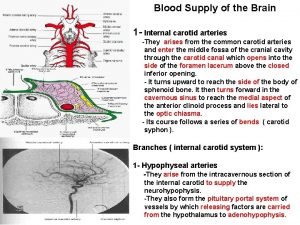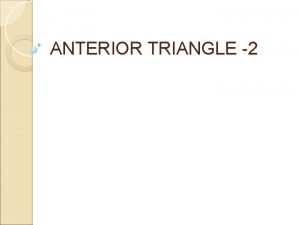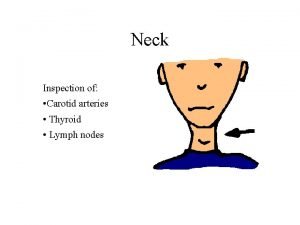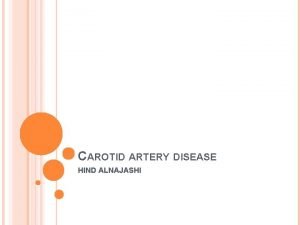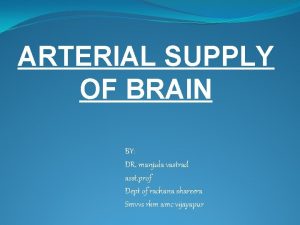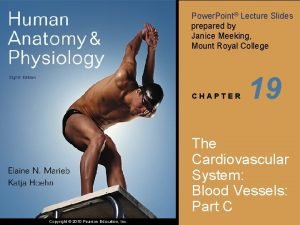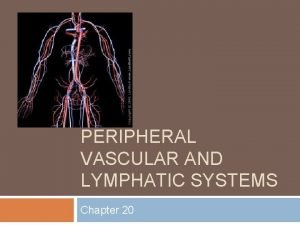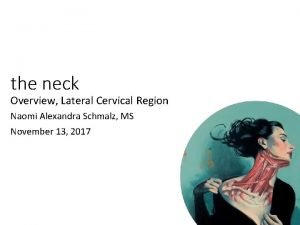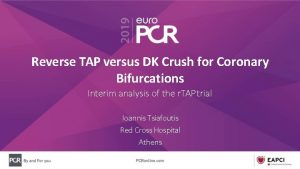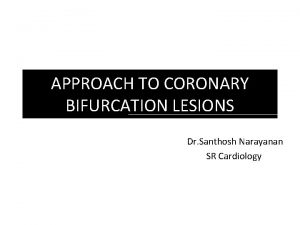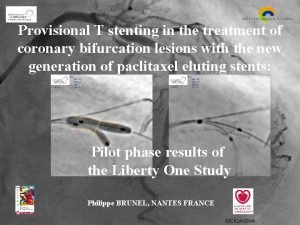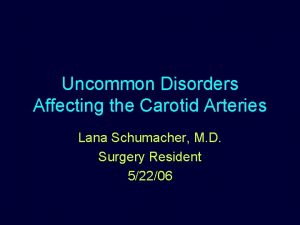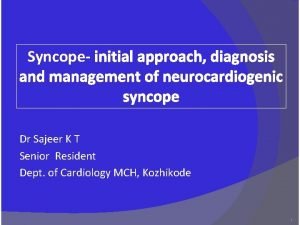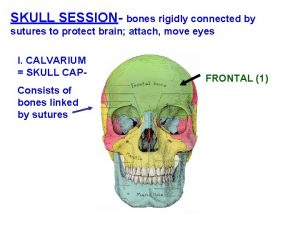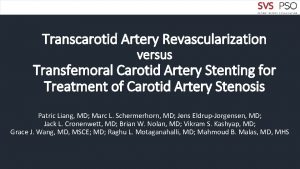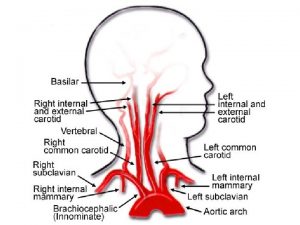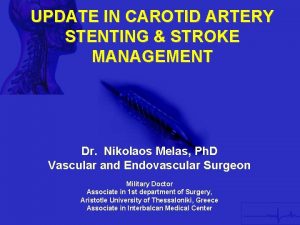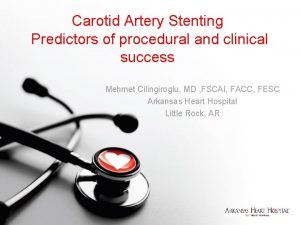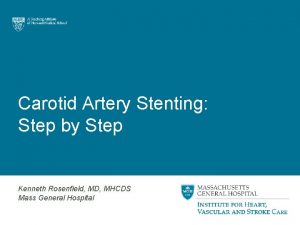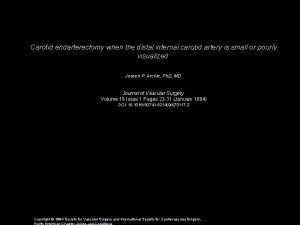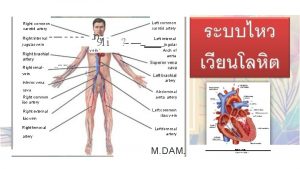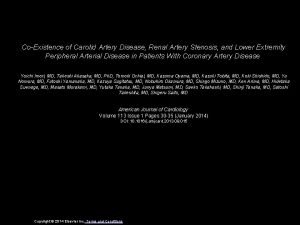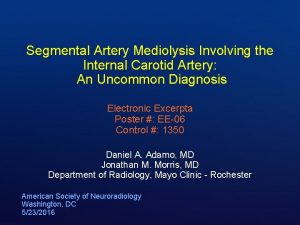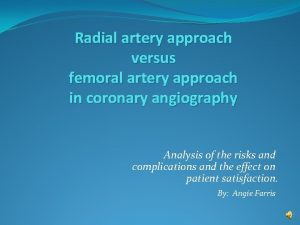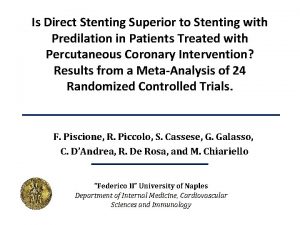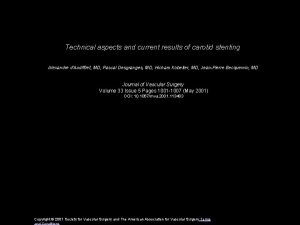Open cervical approach for carotid artery stenting St




















- Slides: 20

Open cervical approach for carotid artery stenting St. Anna Hospital Sofia Cardiology department Dr. V. Velchev Tokuda Hospital Sofia Vascular Surgery and Angiology Department Assoc. Proff. V. Chervenkov, Dr. A. Daskalov

• In last decades, vascular surgery has been revolutionized by endovascular techniques that allow percutaneous vascular intervention. • Advances in biomaterials and biotechnology had given a variety of lowprofile equipment and improved balloon and stent design. • Although the majority of carotid stenting procedures can be performed using the retrograde femoral artery approach, there are some anatomical variations of aortic arch and aortic arch branches which can make retrograde carotid stent delivery nearly impossible.

“Unfavorable” anatomy aortic arch

Bovine arch Tortuosity

Absence of accessible common femoral artery Abdominal aortic occlusion Present Aorto-bifemoral bypass Pulseless disease (Takayasu's arteritis)

Alternative Vascular access • Radial or brachial access: does not overcome a tortuous supra-aortic trunk anatomy and only provides meaningful advantages for the right carotid artery. The small caliber of the radial artery increases the risk of arterial injury. • Transseptal access: requires special skills and support and does not overcome the challenges imposed by an unfavorable anatomy of the aortic arch and its branches. • Percutaneous transcervical CCA access: difficult access-site management after sheath removal, especially in patients who require large guiding catheters and who are treated with both antiplatelet and anticoagulant medications, despite of using closure devices.

What to do if it is impossible to cannulate common carotid artery ?

What to do if it is impossible to cannulate common carotid artery ? Carotid Endarterectomy (CEA) ?

Limitations of CEA • Patients with distal internal carotid artery lesions that are difficult to access via endarterectomy (mandibular subluxation). • Patients who have undergone radiation therapy to the cervical carotid area. • Patients who have previosly undergone ipsilateral CEA or other surgery in this area. • Patients with severe comorbidity.

Surgical exposure of the carotid arteryadvantages • Major advantage of the transcervical surgical access with a carotid cut down compared to transfemoral access is that the aortic arch is not passed, which eliminates the risk of atheroembolization at the time of catheter and wire navigation through the aortic arch and supra-aortic trunks. • Provides a safe access with surgical closure of artery puncture. • In cases of retrograde CAS for stenosis of the proximal CCA there is a good protection against embolism. • Possible to perform under local anestesia.

Technique The common carotid artery is exposed along a short segment just above the clavicle on the side of the intended stent deployment and is held with a vessel loop. From this point on the procedure is identical to a percutaneous retrograde approach. Once the procedure is complete, a surgical suture of the vessel wall is done and the wound is closed.

Case report • 76 -year-old male patient. • Right hemispheric transient ischemic attacks in past three months. • Left hemispheric stroke two years ago.

• Risk factors: Diabetes mellitus type II, Hypertension, Hyperlipaemia. • Duplex: Occlusion of LICA, 40% stenosis of RICA at the bifurcation, followed by a highgrade stenosis (85%) in submandibular area.

Initial angiography: Occlusion of LICA Stenosis of RICA

• RICA stenting procedure via transfemoral and left radial approach failed due to anatomical reasons ( type III aortic arch). • CEA was not acceptable because of submandibular location of highgrade stenotic lesion of RICA. • A hybrid procedure was performed, combining surgical exposure of the common carotid artery, followed by endoluminal stenting of RICA.

Procedure Passing the lesion with 0. 014 guidewire and placing a protection device: Initial angio:

Procedure After predilation with 3, 5/22 mm balloon: Releasing a Cristallo ideale 9/30 mm:

Procedure Result after postdilation with a 4/25 balloon

Conclusions • In patients who are unsuitable for transfemoral access due to unfavorable aortic arch/supra-aortic trunk anatomy, a direct transcervical approach with a carotid cut down can be useful for the endovascular treatment of carotid artery disease. • This technique allows the achievement of hemostasis in a controlled fashion at the end of the procedure despite the use of anticoagulation. It is a safe and effective alternative method in cases in which a distal arterial access cannot be used.

THANK YOU FOR YOUR ATTENTION!
 External carotid
External carotid Internal carotid artery supply
Internal carotid artery supply Triangle
Triangle Left common carotid artery
Left common carotid artery Blood vessel model
Blood vessel model Preauricular lymph node
Preauricular lymph node Amourosis fugax
Amourosis fugax Basilar artery course
Basilar artery course Internal carotid artery
Internal carotid artery Carotid artery pulse
Carotid artery pulse Retract defintion
Retract defintion Scalenes
Scalenes Thyrocervical trunk
Thyrocervical trunk Reverse tap technique
Reverse tap technique Mini culotte stenting
Mini culotte stenting Inverted provisional stenting
Inverted provisional stenting Celiac artery and mesenteric artery
Celiac artery and mesenteric artery Open innovation open science open to the world
Open innovation open science open to the world Lana schumacher md
Lana schumacher md Carotid sinus hypersensitivity
Carotid sinus hypersensitivity Facial foramen
Facial foramen

